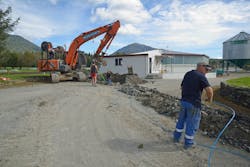This year, across the United States, BEAD-funded rural broadband projects will start the next phase, which is a major step forward in the process. There is a lot at stake. Over 40 billion in funding from the federal government, and millions of Americans lacking the broadband access needed to connect with healthcare, education, and income.
Service providers, construction firms, federal regulators, healthcare facilities, schools, state and local governments—all these parties and many more will need to work together to make it happen.
Are we ready?
The BEAD Challenges Ahead
The next big step is the challenge process, which we are already seeing. And for those interested, the NTIA has set up transparent tools to track progress across the U.S. At the state level is where the rubber meets the road, with states working on identifying which areas are unserved. Here’s Arizona’s map of coverage for one state’s example.
Telecom Construction and Labor Costs
Rob Laudati from Render Networks, a digital construction management platform, told ISE that before you even get to BEAD concerns, there is a host of challenges the industry is facing this year. For example, cost pressure and labor shortages.
“The bottom line is construction costs are increasing dramatically.” Laudati points to report from the Fiber Broadband Industry that two thirds of construction costs are labor, whereas about a third are materials. And that’s assuming you have a capable, abundant workforce to utilize in the first place, which concerns Laudati. “For every five construction workers leaving the industry, one is entering,” Laudati says, drawing from what Render has seen taking place in the industry.
Trent Edwards from Mears Broadband calls this “The Great Build.” He echoes the same workforce concerns that Laudati expressed, saying a lot of folks in the industry have concerns around “people to do this work.”
Edwards also points to construction costs. “70-80% of your network costs are construction,” he points out. “There’s a difference in what can be constructed, and what is planned to be constructed.”
Planning Around BEAD
And what does BEAD add to the mix? “The fact is, the pressure on organizations, both the grantees and their contractors, the subgrantees, to create a design that’s efficient, that’s accurate, and [with which] they know exactly what needs to be built, is going to be critical,” says Laudati.
“Companies who previously haven’t seen the need, or the momentum to need, this type of system … There’s a real opportunity now, and a need in the industry, to be more predictive, more efficient in the actual construction process.”
Laudati points to his company’s role in assessing the scope of work, performing surveys, and optimizing resources, because constructing these networks may be a ways out. “Once those plans are built and the funding is appropriated, what we’re hearing is there may be up to two years before those designs are actually constructed, well into 2025.”
Edwards emphasizes the outcome will depend on effectively working within constraints. “What we’re trying to do is ensure that these rural, these underserved communities are getting maximum output, maximum connections under these very strict budgets.”
What We Have to Do
Edwards points out that with all the money that’s being distributed, it’s going to be crucial that it’s going to the right things. “We need to ensure that it’s being allocated correctly,” which he says is ultimately going to come down to “cost and schedule.”
“Choose your partners early,” he says. And though historically there has been deep competition, Edwards says “we’re going to have to team up.” He uses the portmanteau term of “coop-eratition” (cooperation and competition) and believes that engineering firms, construction companies, material vendors, support functions, etc. will need to be united. “Hell or high water, we’re gonna change this industry,” he adds.
Hopefully that attitude is contagious.
About the Author
Joe Gillard
Executive Editor
Joe Gillard is a media professional with over 10 years of experience writing, editing, and managing the editorial process across a spectrum of innovative industries. Joe strives to deliver the best possible editorial product by focusing on the needs of the audience, utilizing the data available, and collaborating with a talented team.


